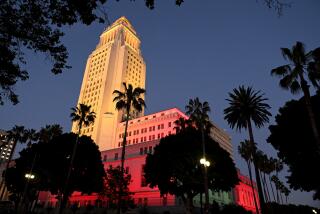Hamilton Goes, 15 Fiefdoms Stay
- Share via
After more than a year of whispers out of City Hall, the word at last has come from Mayor Tom Bradley that Calvin Hamilton will be resigning as planning director. No one can ever accuse the mayor of acting impetuously.
But typical of Bradley, he equivocated as to when Hamilton will be leaving. It seems it will not be before April so that Hamilton can host an American Planning Assn. national conference here--an association presently investigating Hamilton for alleged violations of its code of ethics.
We now can look forward to having a lame-duck planning director.
Actually, Hamilton has not been much more these last few years, given his numerous trips abroad as a consultant to other cities, his leave of absence following the disclosure of a conflict of interest and the resulting loss of credibility so vital to being an effective planning director.
But Hamilton’s failure as a planning director was not all of his making. Contributing also was the City Council and the mayor himself. They have combined--sometimes by neglect, other times by intrusion--to make planning in Los Angeles at best an afterthought in an often nasty development process.
Good planning in the form of good design to create pleasant places to work, live, shop and play has popped up here and there in Los Angeles. But most of these places have been created, not because of the city’s planning review process, but rather often in spite of it and by sheer luck or persistence.
For instance, Melrose Avenue flowers despite its trees being cut down and its sidewalk being narrowed. But imagine how much nicer the serendipitous street could have been with wide, tree-shaded sidewalks, letting cafes spill out onto them, a bench here and there for people watching, if not just resting one’s feet. It almost makes me cry to think of the urban design opportunities Los Angeles has fumbled away.
As for Hamilton, there were in his 20 years in office--in addition to his occasional lapses of judgment--flashes of insight, unabashed enthusiasm and the ability to recognize a good idea. This included the concept of focusing high-density, mixed-use development in satellite centers across the city, which his staff developed and Hamilton embraced and promoted.
Much of the problem of the city’s planning process is the city’s convoluted political system, which divides the city into 15 fiefdoms. It is tough enough being a planning director accountable to one mayor, but having to be in effect 15 planning directors accountable to 15 council members is really beyond any one person’s ability. No wonder Hamilton liked to go on so many trips.
Barring an unlikely revision of the city’s charter (no one in any political system can be expected to be enthusiastic about giving up power), what is going to be needed to bring sensitive planning practices to Los Angeles is a commitment by the mayor in more than just an occasional speech.
But to be sure, the commitment must be to the planning practice, not necessarily the planning director, a mistake Bradley seems to have made in his protracted support of Hamilton. While the so-called Hamilton affair has dragged on and on, the city’s already weak planning process has been weakened even further.
Aggravating the situation has been the Bradley-appointed Planning Commission that, despite sporadic statements by chairman Dan Garcia, has not offered any real leadership in recent planning controversies.
This is unfortunate. The city is in desperate need of some planning, what with its varying degrees of frustrating traffic, pollution, fragmentation, haphazard development, bad design, poor housing, threatened landmarks, oppressed pedestrians and abused ecosystem--as well as its benign climate, magnificent beaches, stunning topography, diverse population and potential for the good life.
However, the planning should not be on a grand, regional scale, replete with thick studies and multicolored maps presented at a seemingly endless series of seminars and conferences presided over by pedantic professors and babbling bureaucrats. We have had enough of those efforts for awhile.
What is needed is planning on a practical, block-by-block, neighborhood level involving those who will be affected. It is time for fewer reports to be filed away in some cabinet and more sensitive plan reviews, perhaps even a suggestion of an amenity or two, such as tree plantings and street furniture.
With an end in sight to the Hamilton debacle, it is time for city planners to be assertive and involve themselves in the urban-design process, to turn off their computers and desk calculators, to rise from their encrusted desks and to get out of their cars to walk the streets of the neighborhoods of their concerns.
As a matter of fact, it wouldn’t be a bad idea if all city officials involved in the planning process did the same.
Perhaps then they would not be so quick to approve a street widening, a demolition of a landmark or the construction of some out-of-scale, out-of-character project. Perhaps then they would begin to understand how planning, if carried out on a human scale and with those affected in mind, can make a good city great.
More to Read
Sign up for Essential California
The most important California stories and recommendations in your inbox every morning.
You may occasionally receive promotional content from the Los Angeles Times.













